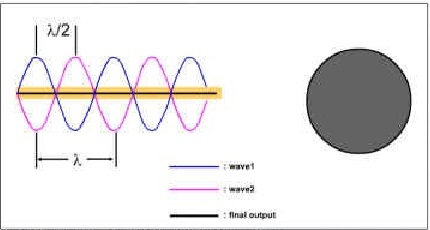There are two reasons for the interference of light.
The first light image is like a wave. It has the characteristics of waves. When we throw a small stone in a pond, we will see a lot of spread outward. This is the wave, and the light can be described by waves.
The principle of superposition of the second wave. The reason why we can see the change of the interference fringes is because of the superposition principle, which is the basic condition that causes the interference phenomenon of the light. In addition, the characteristics of the polarized light, whether the phase is the same, also causes the light. The condition of the interference phenomenon.
There are two kinds of interference phenomena under the superposition principle, destructive interference and constructive interference.

1. Destructive interference As shown in the figure above, if the highest value of the blue wave is at the same position as the lowest value of the red wave, the added value is 0, so when the blue and red waves appear together, When added up, it will become the black line in the middle, because light has the characteristics of waves, so if the two wavelengths are exactly half the wavelength of each other, that is, when the phase difference is π, the picture will be full or dark and completely No streaks, the above picture shows that because the highest point of the blue wave to the highest point of the red wave is different by π, we call it destructive interference.
2. Constructive interference is shown in the figure below. If the blue wave and the highest value of the red wave are at the same position, the added value is 2. When the blue wave and the red wave are completely overlapped, they are superimposed. It will become a higher black line. When we see it with the naked eye, the highest point of the black line will become brighter, the lowest point will be darker, and there will be light and dark lines. We will call it constructive interference when it is blue. When the sum of the wave and the red wave is within 0 to 2, the wavelength will be relatively flat, and the gradient of the gray scale will change.

For constructive interference, the difference between the two waves must satisfy the formula: optical path(n*d)=mλ. The optical path is the optical path difference. The optical path difference is the difference between the two waves. When the two lights run from point A to point B, the distance is d and d', so one wave ran nd and the other wave ran. Nd' then the difference between the two lights is n(d'-d), which can also be nd2'. If nd2' is an integer multiple of the wavelength λ, there will be a change in the light and dark stripes, that is, constructive interference and vice versa. Destructive interference fringes occur when nd2' is exactly half the wavelength of the technology. The formula is: optical path(n*d)=mλ/2

